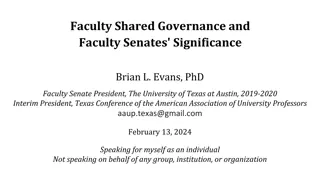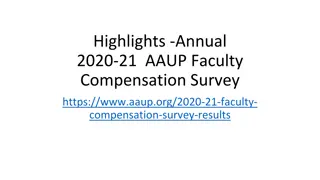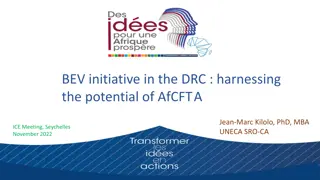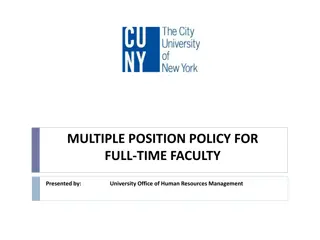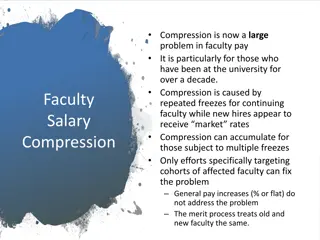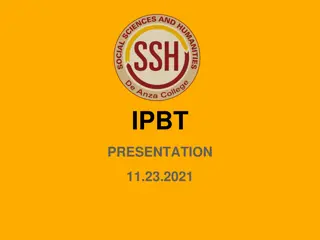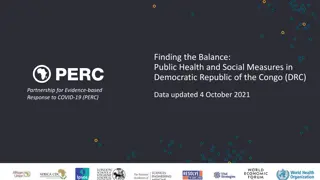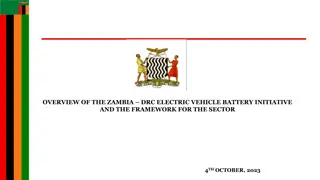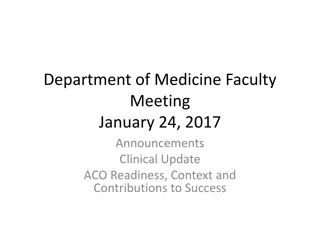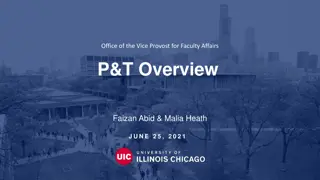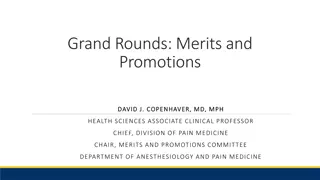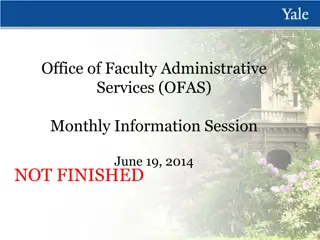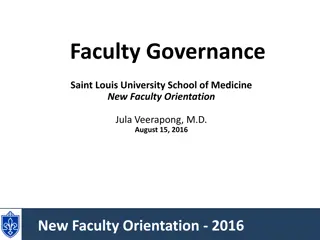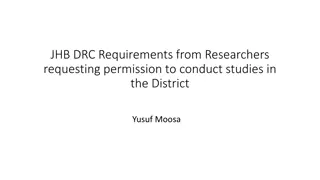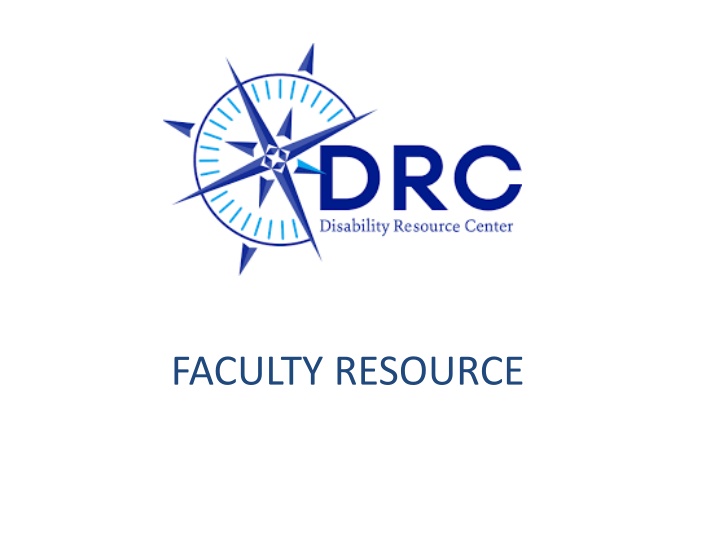
Disability Resource Center (DRC) at Norco College
Explore the role of faculty in providing academic adjustments for students with disabilities at Norco College's Disability Resource Center (DRC). Learn about the student population, DRC statistics, types of disabilities served, and the importance of inclusive education. Discover the impact of disabilities in higher education and how to support students effectively.
Uploaded on | 3 Views
Download Presentation

Please find below an Image/Link to download the presentation.
The content on the website is provided AS IS for your information and personal use only. It may not be sold, licensed, or shared on other websites without obtaining consent from the author. If you encounter any issues during the download, it is possible that the publisher has removed the file from their server.
You are allowed to download the files provided on this website for personal or commercial use, subject to the condition that they are used lawfully. All files are the property of their respective owners.
The content on the website is provided AS IS for your information and personal use only. It may not be sold, licensed, or shared on other websites without obtaining consent from the author.
E N D
Presentation Transcript
Purpose Who are OUR students? What is DRC? Faculty s Role in Providing Academic Adjustment How to Refer a Student to DRC? Universal Design Learning (UDL) Questions & Answers
Who are OUR students? 2014-2015 Enrolled 13,045 Students DRC - 439 students 3% student population 2015-2016 Enrolled 13,337 Students DRC - 481 students 3.6 % student population 2016-2017 Enrolled - 13,958 Students DRC - 483 students 3.5 % student population 2017-2018 Enrolled 14,624 Students DRC - 571 students 3.9 % student population 2018-2019 Enrolled 15,280 Students DRC - 678 students 4.4 % student population 2019-2020 Enrolled 16,594 Students DRC - 730 students 4.4 % student population
Something to think about The California Community Colleges State Chancellor s Office reports that approximately 11% of the CCC students have a disability. In Basic Skills classes this number can jump up to 13%. However, statewide only about 5.2% of the student body is served through DRC offices. At Norco, 4% of the student body is served through DRC. This means that roughly 1500+ students at Norco have not self-identified as having a disability. Of the 730 students with disabilities served at Norco, the fastest growing populations include Autism Spectrum Disorder, Acquired Brain Injury and Mental Health Disorders. The latter two have increased primarily because of the number of returning veterans from the military.
What is a Disability? a physical or mental impairment which substantially limits one or more major life activity (e.g., caring for oneself, performing manual tasks, walking, seeing, hearing, speaking, breathing, learning, working) and (ii) has a record of such impairment.
Did you know? People with disabilities constitute our nation s largest minority group, which is at the same time the most inclusive and the most diverse. -Institute on Disability, University of New Hampshire 2011 The disability community is the only minority group that anyone can join at any time and if you live long of enough you will -Unknown
We have to remember disability is just ONE factor or aspect about a person.
What Does the LAW say? Rehabilitation Act of 1973 No otherwise qualified individual with a disability in the United States, as defined in section 705 (20), shall, solely by reason of the disability, be excluded from the participation in, be denied the benefits of, or be subjected to discrimination under any program or activity receiving Federal financial assistance Americans with Disabilities Act Amendments Act of 2008 (ADAAA) the college shall provide accommodations unless: the college can demonstrate that the academic adjustments are not necessary to ensure nondiscriminatory participation by a student with a disability, or the college can demonstrate that the academic requirement for which an adjustment is requested is essential to the program of instruction being pursued by the student. Section 508 of the Rehabilitation Act districts are required to adopt policies and procedures to ensure that all electronic and information technologies are accessible to persons with disabilities. Before the district or college can legally purchase any software, hardware, operating system, telecommunication product, or other electronic or information technology, there must be policies and procedures in place to ensure that persons who use adaptive technology can access the information or program. In addition, all college and district web sites must be designed in such a way so that they are accessible to persons who use adaptive technology, such as screen readers and braille displays. Title 5, California Code of Regulations Each community college district has primary responsibility to insure that its programs and activities are available to all persons without regard to ethnic group identification, national origin, religion, age, race, sex or gender, color, sexual orientation, ancestry, or physical or mental disability...
Who is eligible for services? Physical Disability Communication Disability Acquired Brain Injury (ABI) Intellectual Disability Mental Health Other Health Disabilities Learning Disability Deaf/Hard of Hearing Blind/Low Vision Autism Spectrum Disorder ADD/ADHD Meet Title 5 definitions
Areas of difficulty Attention Auditory Processing Visual Processing Motivation Motor skills Executive functioning Emotional regulation Memory Reading body cues and facial expressions Social skills Pragmatics Variety of interests Figurative language Changes in routine Managing sensory input
DRC Services Note Taking Assistance Interpreters or Captioners Test Proctoring Alternate Media Formats Adaptive Computer Equipment Adaptive Furniture Liaison with campus services and community agencies Academic Planning and Support
The Transition K-12 COLLEGE Follow IDEA (Individuals with Disabilities Education Act), ADA, Section 504 of the 1973 Rehabilitation Act. IDEA is about SUCCESS Follow ADA, Section 504 of the 1973 Rehabilitation Act ADA is about ACCESS School is responsible for IEP (Individualized Education Plan) and/or 504 plan Student must provide documentation of functional limitations and demonstrate the need for specific adjustments Purposed outcomes, evaluation criteria, and instructional practices can be modified Reasonable adjustments in instructional programs which do not alter the essential content or requirements Special classes and placement must be available to students Colleges are not required to provide special classes or programs for students with disabilities Teachers often take time to remind student of assignments and dates Instructors expect the student to read, save, and consult the course syllabus. Adjustments are automatic Student driven process, they must request Parent advocates for student Student advocates for self
Facultys Role Instructors play a key role in the academic adjustment process The level of involvement faculty will have in the academic adjustment process will vary depending upon the following factors: the type of academic adjustment prescribed the setting for the academic adjustment the functional limitations of the student s disability. Faculty are always welcome to facilitate any educational academic adjustment as this promotes integration rather than segregation of the student with a disability.
Faculty Rights and Responsibilities Faculty members have the right to: Set and post academic standards for all students. Evaluate all students based on the standards of the class and to grade accordingly. Faculty members have the responsibility to: Use DRC as their resource to assist them in the provision of academic adjustments in a timely, reasonable and equal manner. Adjust methods of delivery of content and assessment of student knowledge without fundamentally altering the nature of the course. Provide handouts and exams in a timely manner and in accessible formats for alternate media provision. Select textbooks in a timely manner so that e-text can be ordered from the publisher or converted by the DRC office.
Faculty Rights and Responsibilities continued Faculty members have the responsibility to: Respect and maintain a student's right to confidentiality about his/her disability by not announcing or discussing the student's disability in the presence of other students or staff. Contact DRC if there is a concern about any academic adjustment. Work with all campus resources including DRC to ensure that EIT (educational instructional technology) is accessible to students who use assistive technology. Faculty do not have the right to refuse to provide any academic adjustments, to question whether the disability exists when academic adjustments have been authorized by DRC, to inquire about the nature of the student s disability or to examine the student s documentation.
Identifying Students Who May Benefit from DRC in the Classroom STUDENTS WHO: Perform well on homework and in-class applied learning activities but do poorly on tests. Have difficulty expressing themselves verbally. Have difficulty with written expression or demonstrate poor grammar. Clearly process information at a slower pace than the rest of the class. Skip steps in solving formulas or misapply steps.
Students may say they Become anxious and go blank on tests. Need more time on tests and quizzes. Have horrible handwriting and/or always have been a poor speller. Have a history of Special Education classes (also called RSP, SDC, LH, 504 plan, IEP, Intervention class, etc.). Have repeated the current course more than once. Have a hard time keeping up in lecture. Have difficulty taking notes. Have difficulty sustaining attention and concentration. Have poor study skills.
Referring Students to DRC Share with students that there are resources on campus that may help them. If they mention a history of Special Education or are a veteran, tell them that DRC can provide them with many services that might be helpful. If there is no disclosed diagnosis, then tell them that free learning evaluations are offered on campus by Kimberly for students with learning difficulties like theirs. Try not to say disability. Some students are uncomfortable with the term for cultural or other reasons and will not follow through on the referral. Stick to learning difficulties and learning evaluation. Resistant Veteran? Refer to the VRC and the 9 Line Project
LD Testing Process Initial LD Intake and Screening booklet given by DRC front desk is completed in office. Intake interview is scheduled Review of Special Education records, prior documentation or outside assessment, if applicable. Testing is scheduled Cognitive testing completed Achievement testing completed Results appointment. If found eligible, review of services and academic planning.
Learning Disability Possessing average to above average intelligence. Demonstration of a cognitive processing deficit. Demonstration of an aptitude-achievement discrepancy in at least one academic area. May be in isolation or coexisting with other disabilities.
Follow- up Ask the student to follow-up with you and let you know when he/she sees Kimberly. Arrange for the student to tell you before or after class, or during your next office hour. If the student doesn t bring it up, ask her/him (privately if possible) how it went at the DRC office (or coded, at that resource I referred you to. ) Call or email me to let me know you referred a student. You can provide additional information if you d like; however, it is NOT a two-way street. Due to confidentiality we cannot release information without the student s consent.
After the Referral You are not required to provide academic adjustments for students unless they have a verified disability. You may request a DRC Letter to Instructor as proof from DRC before making adjustments for students. Students are not required to share with you their actual diagnosis, but rather their functional limitations due to their disability that warrants the adjustment. In discussing an adjustments, instead of asking what their disability is, discuss what functional limitations are posing a barrier in your class.
Universal Design According to the Center for Universal Design (UD) at North Carolina State University, UD is the design of products and environments to be usable by all people, to the greatest extent possible, without the need for adaptation or specialized design."
Universally Designed Learning (UDL) Research shows that all students benefit from multimodal, multisensory teaching strategies. Both students with and without disabilities benefit from an universal design approach.
UDL in Delivery Methods Use multiple, accessible instructional methods that are accessible to all learners. Examples: Use multiple modes to deliver content When possible, allow students to choose from multiple options for learning Motivate and engage students - consider lectures, collaborative learning options, hands- on activities, Internet-based communications, education software. (Adapted from the publication Universal Design of Instruction: Definition, Principles, Guidelines, and Examples )
To support diverse recognition: Provide multiple examples Highlight critical features Provide multiple media and formats Support background context (UD teaching methods, Rose & Meyer, 2002)
To support diverse strategic mastery: Provide flexible models of skilled performance Provide opportunities to practice with supports Provide ongoing, relevant feedback Offer flexible opportunities for demonstrating skill (UD teaching methods, Rose & Meyer, 2002)
Allow multiple means to demonstrate learning Use of portfolios Graphic work, not just text-based alone Collaborative group reports and presentations Video projects or website design Think of ways a student can show mastery of material other than just writing a report or taking a traditional test
What are we really measuring? Consider what student learning outcomes you are actually trying to measure/teach. Are you measuring ability to take timed tests? If not, why not give all students extended time? Are you measuring recognition of truths (multiple-choice tests)? Why not have a multiple format test that includes short answer questions? Is spelling essential to show mastery of this concept? Why not let all students digitally record your lectures?
Universally designed learning sounds a lot like best practices in teaching!
Questions? Comments? Kimberly Bell Kimberly.bell@norcocollege.edu Thank you for attending!


